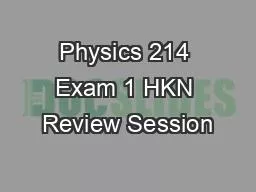

Steven Kolaczkowski Dhruv Patel Traveling Waves and Harmonics The standard equation for a traveling wave is the Amplitude of the wave the wavenumber associated with the waves momentum and has units of ID: 813121
Download The PPT/PDF document "Physics 214 Exam 1 HKN Review Session" is the property of its rightful owner. Permission is granted to download and print the materials on this web site for personal, non-commercial use only, and to display it on your personal computer provided you do not modify the materials and that you retain all copyright notices contained in the materials. By downloading content from our website, you accept the terms of this agreement.
Slide1
Physics 214Exam 1 HKN Review Session
Steven Kolaczkowski
Dhruv Patel
Slide2Traveling Waves and Harmonics
The standard equation for a traveling wave is
: the Amplitude of the wave : the wavenumber, associated with the wave’s momentum and has units of () : the radial frequency, has units of , related to standard frequency () by : the relative phase of the waveEx: This is for a wave traveling in the positive x directions
Slide3Adding Waves and Intensity
Waves can constructively or destructively interfere
Intensity (
): A measure of the power provided by a wave over a given area
,
If
then
Slide4Phasors
A mathematical tool to help visualize time dependent systems
Each phasor, like a vector, has a magnitude and a direction
In this course we will only deal with phasors that share a frequency (YAY!!!)When adding phasors, we must account for their relative phase to each otherSince all frequencies are the same, adding phasors is just like adding vectors (because it is)It is the projection of these vectors onto the horizontal axis that we care about (in this class)
Slide5Interference
Interference Minima: N slits there are (N-1) minima between maxima
Peak Thickness: Thickness is proportional to
(the more slits, the skinnier the peaks are)Maxima Location: Located every phase change of or when interfering waves are integer wavelengths out of phase. under small angel approximation: where d is the distance between slits and is the wavelength.Minima Location: Located every phase change of Intensity: where
Slide6Diffraction
We can have interference between a wave going though a single slit!
This patter will have minima when the waves from the top of the slit destructively interfere (are
out of phase)This happens at angles described by or if angles are small Intensity: Notice: and are essentially the same thing, only one uses the slit spacing (d) and the other use the slit width (a)
Slide7Diffraction and Interference AT THE SAME TIME!
Don’t panic! We still get to use all the equations from before, we just need to make sure we account for both mechanism.
Multiplying these two factors together we get
the gross equation:
Slide8Rayleigh Criteria
Need to be able to differentiate two waves that are next to each other in a grating
Rayleigh Limit
Light from two sources can be differentiated if they are a certain angle apart where for holes and for slits. is the slit width and is the diameter of the beamThis can be translated to a spatial size of beam limit
Slide9Photons (
): Treating light as a particle
h is Plank’s constant = pronounced “h-bar”When we work with quantum particles we describe them by their wavefunction ()[Insert physical interpretation of here], while is the probability of finding the particle at a specific locationWe can treat the just like we treated and just like A
IT’S THE SAME AS BEFORE!!!
Distinguishable vs. Indistinguishable
If we know exactly what path the particle is taking, If we have no way of knowing the path, This is by far the more useful case in quantum mechanics and where all the craziness comes from
Slide10Particles? Waves? What’s the difference‽
How do we assign momentums to massless things like photons?
We use the
DeBroglie Equation Energy:Massive particles: Light: Well how do we assign wavelength to a massive particle?DeBroglie again!!!
Slide11Time Independent Schrödinger Equation (TISE) and the Infinite Potential Well
Free Particle solution: if we have no potential ,
, then our original harmonic wave solutions works and we can say
or You can verify that this will get us
Infinite Square Well: We need a function that is zero at x=0 and x=L
From our options above,
works if and is the energy level of the system
Slide12Finite Potential Wells and Boundary Conditions
Normalization: since
is a probability, the sum of all probabilities must be one
With changing potentials we force two boundary conditions to be met: and
Slide13Exam Advice
Know when and how to use your equation sheet
Don’t panic, just keep on moving
Make sure you are in the right mindset going into the examSpend your time showing what you knowDON’T CHEAT
Slide14Past Exam Questions
Slide15Spring 2017
Slide16Spring 2017
Slide17Spring 2017
Slide18Spring 2016
Slide19Fall 2016
Slide20Fall 2016
Slide21Fall 2016
Slide22Fall 2015
Slide23Fall 2015
Slide24Fall 2014
Slide25Fall 2014
Slide26Fall 2014
Slide27Fall 2014
Slide28Fall 2014